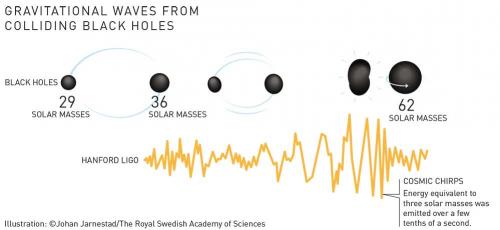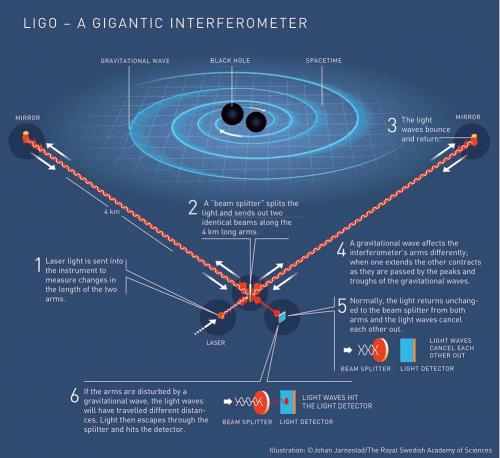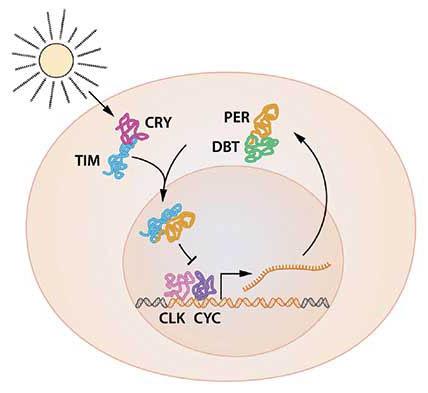Physics: observation of gravitational waves
The Nobel Prize in Physics 2017 was divided, one half awarded to Rainer Weiss, the other half jointly to Barry C. Barish and Kip S. Thorne ‘for decisive contributions to the LIGO detector and the observation of gravitational waves’.
On 14 September 2015, the universe’s gravitational waves were observed for the first time. The waves, which were predicted by Albert Einstein 100 years ago, came from a collision between two black holes. It took 1.3 billion years for the waves to arrive at the LIGO detector in the USA.
The signal was extremely weak when it reached Earth, but is already promising a revolution in astrophysics. Gravitational waves are an entirely new way of observing the most violent events in space and testing the limits of our knowledge.
LIGO, the Laser Interferometer Gravitational-Wave Observatory, is a collaborative project with over 1000 researchers from more than 20 countries. Together, they have realised a vision that is almost 50 years old. The 2017 Nobel laureates have, with their enthusiasm and determination, each been invaluable to the success of LIGO. Pioneers Weiss and Thorne, together with Barish, the scientist and leader who brought the project to completion, ensured that four decades of effort led to gravitational waves finally being observed.
In the mid-1970s, Weiss had already analysed possible sources of background noise that would disturb measurements, and had also designed a detector, a laser-based interferometer, which would overcome this noise. Early on, both Thorne and Weiss were firmly convinced that gravitational waves could be detected and would bring about a revolution in our knowledge of the universe.
Gravitational waves spread at the speed of light, filling the universe, as Einstein described in his general theory of relativity. They are always created when a mass accelerates, like when an ice-skater pirouettes or a pair of black holes rotate around each other. Einstein was convinced it would never be possible to measure them. The LIGO project’s achievement was using a pair of gigantic laser interferometers to measure a change thousands of times smaller than an atomic nucleus, as the gravitational wave passed Earth.
So far all sorts of electromagnetic radiation and particles, such as cosmic rays or neutrinos, have been used to explore the universe. However, gravitational waves are direct testimony to disruptions in spacetime itself. This is something completely new and different, opening up unseen worlds. A wealth of discoveries awaits those who succeed in capturing the waves and interpreting their message.
Physiology or Medicine: molecular mechanisms of circadian rhythm
The Nobel Prize in Physiology or Medicine 2017 was awarded jointly to Jeffrey C. Hall, Michael Rosbash and Michael W. Young ‘for their discoveries of molecular mechanisms controlling the circadian rhythm’.
Life on Earth is adapted to the rotation of our planet. For many years we have known that living organisms, including humans, have an internal biological clock that helps them anticipate and adapt to the regular rhythm of the day. But how does this clock actually work? Hall, Rosbash and Young were able to peek inside our biological clock and elucidate its inner workings. Their discoveries explain how plants, animals and humans adapt their biological rhythm so that it is synchronised with Earth’s revolutions.
Using fruit flies as a model organism, this year’s Nobel laureates isolated a gene that controls the normal daily biological rhythm. They showed that this gene encodes a protein that accumulates in the cell during the night, and is then degraded during the day. Subsequently, they identified additional protein components of this machinery, exposing the mechanism governing the self-sustaining clockwork inside the cell. We now recognise that biological clocks function by the same principles in cells of other multicellular organisms, including humans.
With exquisite precision, our inner clock adapts our physiology to the dramatically different phases of the day. The clock regulates critical functions such as behaviour, hormone levels, sleep, body temperature and metabolism. Our wellbeing is affected when there is a temporary mismatch between our external environment and this internal biological clock, for example when we travel across several time zones and experience jet lag. There are also indications that chronic misalignment between our lifestyle and the rhythm dictated by our inner timekeeper is associated with increased risk for various diseases.
Our inner clock
Most living organisms anticipate and adapt to daily changes in the environment. During the 18th century, the astronomer Jean Jacques d’Ortous de Mairan studied mimosa plants, and found that the leaves opened towards the sun during the day and closed at dusk. He wondered what would happen if the plant was placed in constant darkness. He found that independent of daily sunlight the leaves continued to follow their normal daily oscillation. Plants seemed to have their own biological clock.
Other researchers found that not only plants, but also animals and humans have a biological clock that helps to prepare our physiology for the fluctuations of the day. This regular adaptation is referred to as the circadian rhythm, originating from the Latin words circa meaning ‘around’ and dies meaning ‘day’. But just how our internal circadian biological clock worked remained a mystery.
Identification of a clock gene
During the 1970s, Seymour Benzer and his student Ronald Konopka asked whether it would be possible to identify genes that control the circadian rhythm in fruit flies. They demonstrated that mutations in an unknown gene disrupted the circadian clock of flies. They named this gene ‘period’. But how could this gene influence the circadian rhythm?
This year’s Nobel laureates, who were also studying fruit flies, aimed to discover how the clock actually works. In 1984, Hall and Rosbash, working in close collaboration at Brandeis University in Boston, and Young at the Rockefeller University in New York, succeeded in isolating the period gene. Hall and Rosbash then went on to discover that PER, the protein encoded by period, accumulated during the night and was degraded during the day. Thus, PER protein levels oscillate over a 24-hour cycle, in synchrony with the circadian rhythm.
A self-regulating clockwork mechanism
The next key goal was to understand how such circadian oscillations could be generated and sustained. Hall and Rosbash hypothesised that the PER protein blocked the activity of the period gene. They reasoned that by an inhibitory feedback loop, PER protein could prevent its own synthesis and thereby regulate its own level in a continuous, cyclic rhythm.
The model was tantalising, but a few pieces of the puzzle were missing. To block the activity of the period gene, PER protein, which is produced in the cytoplasm, would have to reach the cell nucleus, where the genetic material is located. Hall and Rosbash had shown that PER protein builds up in the nucleus during night, but how did it get there? In 1994, Young discovered a second clock gene, ‘timeless’, encoding the TIM protein that was required for a normal circadian rhythm. In elegant work, he showed that when TIM bound to PER, the two proteins were able to enter the cell nucleus where they blocked period gene activity to close the inhibitory feedback loop.
Such a regulatory feedback mechanism explained how this oscillation of cellular protein levels emerged, but questions lingered. What controlled the frequency of the oscillations? Young identified yet another gene, ‘doubletime’, encoding the DBT protein that delayed the accumulation of the PER protein. This provided insight into how an oscillation is adjusted to more closely match a 24-hour cycle.
The paradigm-shifting discoveries by the laureates established key mechanistic principles for the biological clock. During the following years, other molecular components of the clockwork mechanism were elucidated, explaining its stability and function. For example, this year’s laureates identified additional proteins required for the activation of the period gene, as well as for the mechanism by which light can synchronise the clock.
Keeping time on our human physiology
The biological clock is involved in many aspects of our complex physiology. We now know that all multicellular organisms, including humans, utilise a similar mechanism to control circadian rhythms. A large proportion of our genes are regulated by the biological clock and, consequently, a carefully calibrated circadian rhythm adapts our physiology to the different phases of the day. Since the seminal discoveries by the three laureates, circadian biology has developed into a vast and highly dynamic research field, with implications for our health and wellbeing.






